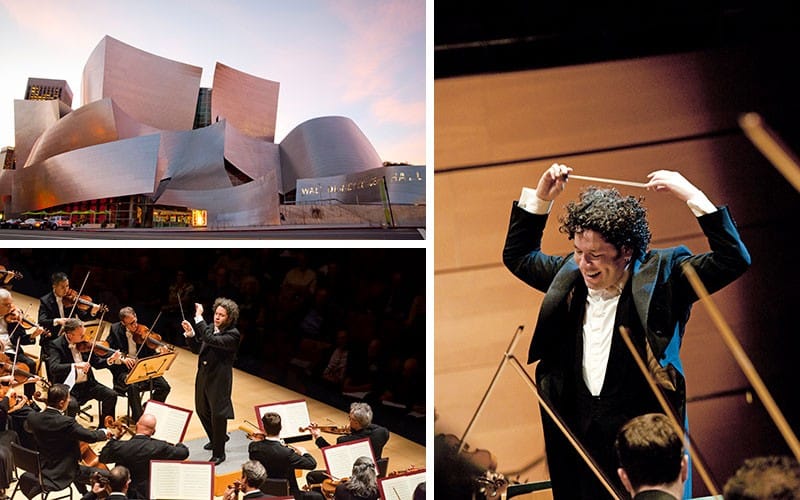Walking into Walt Disney Concert Hall feels like you’re entering a warm cocoon where you know you’ll leave transformed. One cold yet flowery spring evening, LA’s beautiful concrete jungle hosted Mitsuko Uchida as she tickled the ivory keys with luscious fervor. On the rostrum, Gustavo Dudamel led the remainder of the orchestra through Shumann’s Piano Concerto in A minor, Op. 54.
Fans of the Amazon Prime series Mozart in the Jungle may know that Gael Garcia Bernal’s character, Maestro Rodrigo De Souza, is “loosely based” based on the LA Philharmonic’s own Maestro, Gustavo Dudamel. If you’ve ever seen Dudamel conduct an orchestra in person, you’d understand why. Maestro De Souza is exactly the kind of person one would hope Dudamel embodies in real life: intensely enthusiastic, unintentionally reckless, yet magically heroic. It was doubly interesting that, CODA, an organization promoting youth orchestras throughout California, was present that evening. CODA produced an entertaining after party at Walt Disney Concert Hall, specifically for young people who attended the evenings program to enjoy.
Piano Concerto and the Magic Baton
Taking the stage with Mitsuko Uchida, Dudamel stood on the rostrum with the poise of a flower in full bloom. Dudamel embraced the baton in his right hand. Strangely, the hand didn’t move much whilst the baton somehow floated about in the air, like a magic wand of sorts. Dudamel’s hair seemed to be an extension of the baton. It looked as if the hair engaged in after shocks from the baton movements, adding silent intensity to the music. The kind of intensity you might only feel in your mind, where you’re left wondering if others around you felt it too.
If your seats were located in the orchestra west, you’d see the entire orchestra’s facial expressions. You’d notice that, at times, the conductor didn’t move his body or the baton at all. The vivid expressions emitting from his eyes were powerful enough to direct the orchestra.

Spring Symphony Mania
After Uchida rocked the piano concerto, and everyone took a brief intermission, the LA Phil returned to grace the audience with Shumann’s Spring Symphony. It’s widely known that Schumann suffered from what we now call bipolar disorder. Schumann composed this particular symphony in just 4 days, likely during a period of glorious mania.
Prior to beginning the piece, Dudamel informed the audience that they may feel as if they were experiencing two different nights at the symphony. He was right. Allowing Mitsuko Uchida and the piano to co-conduct the first piece along with him, Dudamel then brought Schumann’s raving euphoria to life as he conducted Spring. Suddenly, Dudamel let loose with his gestures and became a part of the orchestra. It looked sort of like a cosmic ballet between the musicians and their musical instruments. A true feast for the ears and quite a scrumptious delight for the eyes as well!
Speaking of delights, one of the most playful aspects of Mozart in the Jungle is the interplay between Maestro De Souza, Wolfgang Amadeus Mozart, and other late composers who “show up” at random points in the series as figments of the Maestro’s imagination. The late great composers, dressed in elaborate wigs and costumes from their own time, appear and banter with the Maestro, often expressing their approval or disdain for the choices Maestro De Sousa makes with their masterpieces.
As the symphony came to a close, the whole house bounced onto their feet with joy. Dudamel walked amongst the orchestra members, expressing his gratitude by shaking hands and gesturing wildly with glee. One wouldn’t be surprised if Robert Schumann was standing right there next to him. Perhaps Schumann was in Dudamel’s imagination or in holographic form, with his signature bushy eyebrows and dressed in a high collared coat with a fancy 1840’s necktie. Schumann was likely smiling and nodding his head in delight over the lovely musical journey Dudamel took the audience on that evening, some 180 years after Spring Symphony was born.
